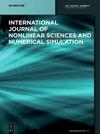新冠肺炎部分传染病模型的稳定性分析与数值模拟
IF 1.5
4区 工程技术
Q2 ENGINEERING, MULTIDISCIPLINARY
International Journal of Nonlinear Sciences and Numerical Simulation
Pub Date : 2022-05-30
DOI:10.1515/ijnsns-2021-0042
引用次数: 8
摘要
摘要本文的目的是建立一个简化的非线性分数阶数学模型,以说明新型冠状病毒(新冠肺炎)的动力学。根据新冠肺炎的传染特征,将人群分为五个区:易感S(t)、无症状感染I(t),未报告的有症状感染U(t)和报告的症状感染W(t)以及康复R(t)。统称为(SIUWR)。建立了模型解的存在性、唯一性、有界性和非否定性。此外,计算基本再现次数R0。考察了模型的所有可能平衡点,讨论了它们在特定条件下的局部和全局稳定性。无病平衡点对R0 leq1是局部渐近稳定的,对R0>1是不稳定的。此外,地方性平衡点对于R0>1是局部渐近稳定的。使用Adams–Bashworth–Moulton型分数预测器-校正器PECE方法进行数值模拟,以验证分析结果并了解参数变化对新冠肺炎传播的影响。对于数值模拟,近似解的行为以各种分数阶的图形的形式显示。最后,对如何对社会工作中的传播动力学进行建模的仿真做了简要的总结。本文章由计算机程序翻译,如有差异,请以英文原文为准。
Stability analysis and numerical simulations of the fractional COVID-19 pandemic model
Abstract The purpose of this article is to formulate a simplified nonlinear fractional mathematical model to illustrate the dynamics of the new coronavirus (COVID-19). Based on the infectious characteristics of COVID-19, the population is divided into five compartments: susceptible S(t), asymptomatic infection I(t), unreported symptomatic infection U(t), reported symptomatic infections W(T) and recovered R(t), collectively referred to as (SIUWR). The existence, uniqueness, boundedness, and non-negativeness of the proposed model solution are established. In addition, the basic reproduction number R 0 is calculated. All possible equilibrium points of the model are examined and their local and global stability under specific conditions is discussed. The disease-free equilibrium point is locally asymptotically stable for R 0 leq1 and unstable for R 0 > 1. In addition, the endemic equilibrium point is locally asymptotically stable with respect to R 0 > 1. Perform numerical simulations using the Adams–Bashforth–Moulton-type fractional predictor–corrector PECE method to validate the analysis results and understand the effect of parameter variation on the spread of COVID-19. For numerical simulations, the behavior of the approximate solution is displayed in the form of graphs of various fractional orders. Finally, a brief conclusion about simulation on how to model transmission dynamics in social work.
求助全文
通过发布文献求助,成功后即可免费获取论文全文。
去求助
来源期刊
CiteScore
2.80
自引率
6.70%
发文量
117
审稿时长
13.7 months
期刊介绍:
The International Journal of Nonlinear Sciences and Numerical Simulation publishes original papers on all subjects relevant to nonlinear sciences and numerical simulation. The journal is directed at Researchers in Nonlinear Sciences, Engineers, and Computational Scientists, Economists, and others, who either study the nature of nonlinear problems or conduct numerical simulations of nonlinear problems.

 求助内容:
求助内容: 应助结果提醒方式:
应助结果提醒方式:


